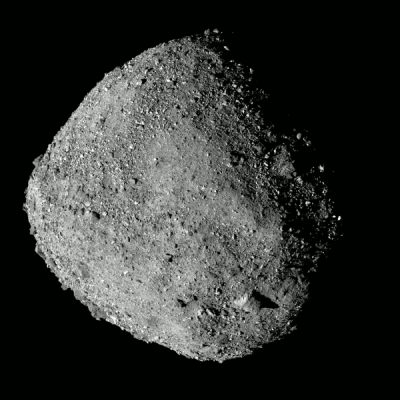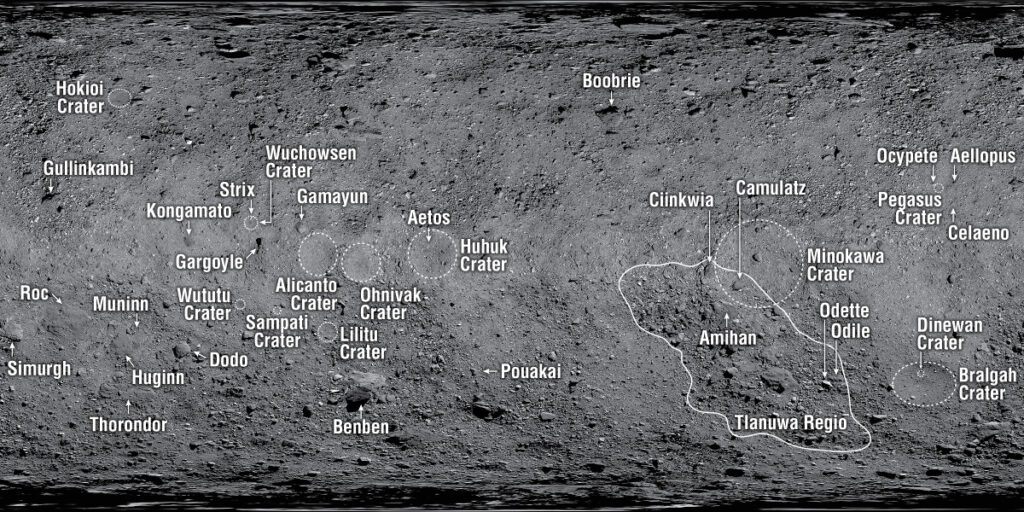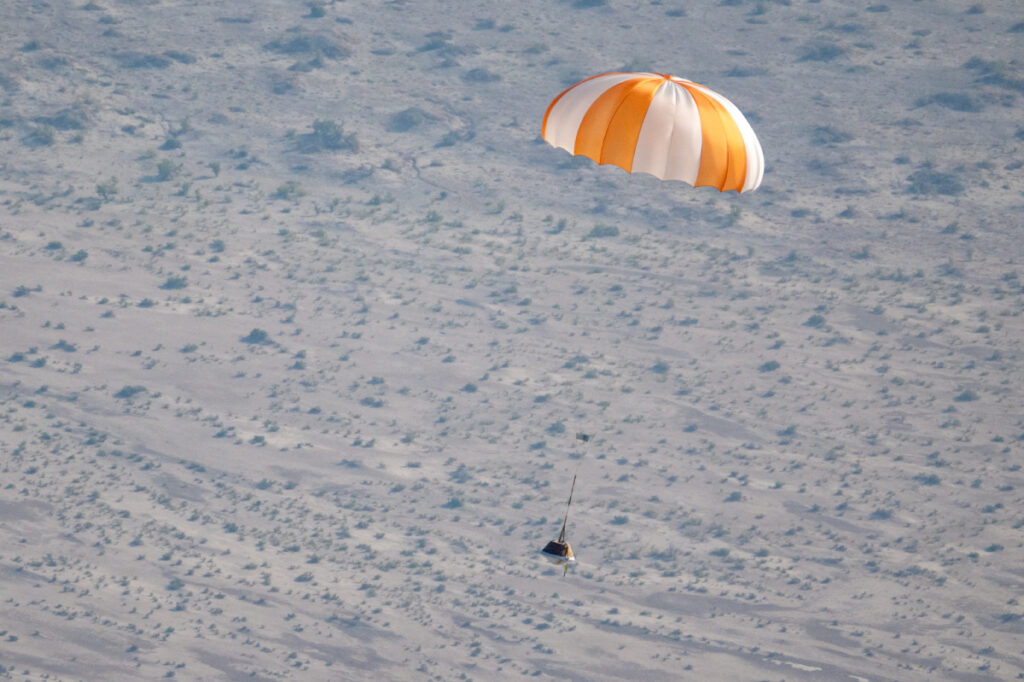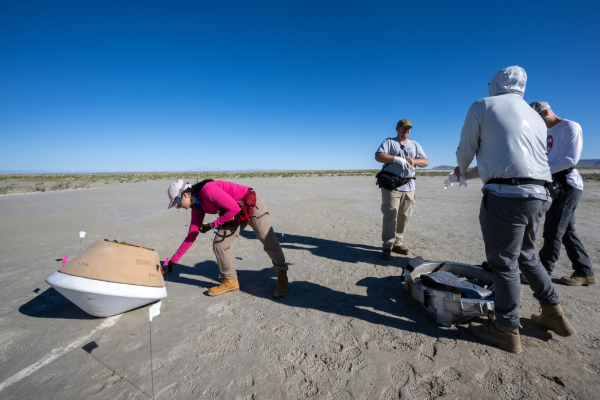Update 25 September 2023: Success! OSIRIS-REx’s sample return capsule touched down in the Utah desert at 8:52 a.m. Mountain Daylight Time on 24 September, 80 miles southwest of Salt Lake City. The capsule was quickly transported via helicopter to a temporary clean room at the Dugway Proving Ground facility. Next, the capsule will be transported to NASA’s Johnson Space Center in Houston, Texas, for sample extraction, processing, and storage.
This week, NASA’s Origins, Spectral Interpretation, Resource Identification, Security–Regolith Explorer (OSIRIS-REx) mission returns to Earth carrying an estimated 250 grams (8.8 ounces) of material gathered from the surface of an asteroid.
The mission milestone has generated a “pretty wild emotional state,” said OSIRIS-REx principal investigator Dante Lauretta, a planetary scientist at the University of Arizona in Tucson. “Obviously excited, and proud of how well we’ve done. I think this team has done an amazing job—I would say, flawless, and the spacecraft is very healthy, performing absolutely perfectly right now.”
The sample return capsule is scheduled for a soft touchdown via parachute in Utah’s desert on the morning of 24 September. Scientists expect that the asteroid samples will reveal details about the history of the solar system and the types of materials that were available to form and seed early Earth.
A 7-Year Journey

OSIRIS-REx launched from Cape Canaveral, Fla., in 2016 and spent 2 years traveling to Bennu, a carbon-rich asteroid that orbits between Earth and Mars. The spacecraft arrived at the asteroid in December 2018 and orbited for 2 years, measuring the asteroid’s mass, density, albedo, surface composition, and particle environment.
During its reconnaissance of Bennu, the mission team discovered that the asteroid is of the rare active variety, meaning that it intermittently ejects material from its surface. The surface is far more rugged than expected, hosting several hundred boulders larger than 10 meters in diameter. Instruments on board the spacecraft also found Bennu’s bulk density to be lower than expected; as much as 60% of the asteroid might be empty space. The surface was covered with hydrated minerals that suggest past aqueous activity, and Bennu’s rotation is speeding up, likely caused by an interaction with solar radiation known as the YORP effect (Yarkovsky-O’Keefe-Radzievskii-Paddack).
“My heart rate really ticked up. It just all of a sudden felt real. We’re pointed at the Earth. No matter what, we’re coming in.”
With images taken during the orbital phase, the mission team created detailed maps of the asteroid’s surface to help select a landing site. On 20 October 2020, OSIRIS-REx successfully touched down on Bennu, spending a few seconds at a landing site named Nightingale to collect material from the surface. After a hiccup in securing the collection capsule wherein a small amount of the sample was lost to space, the spacecraft turned back toward Earth and began its journey home in May 2021.
The spacecraft performed its (probably) final trajectory maneuver on 10 September ahead of the return. “We were off point from the Earth by about 200 kilometers just as a safety,” Lauretta said. When the thrusters pointed the craft back to Earth, “my heart rate really ticked up. It just all of a sudden felt real. We’re pointed at the Earth. No matter what, we’re coming in.”
Why Return Samples?
Material has been collected and returned to Earth from comets, asteroids, the solar wind, and the Moon. Samples returned directly from a source can answer many scientific questions that can’t be answered by remote observations, landers and rovers, or even meteorites fallen to Earth, Lauretta said.
With meteorite analysis, Lauretta explained, you never know the geologic context. “We never know where these came from, how abundant [or] how common they are, how likely [they are] to be delivered to the early Earth.” With the Bennu sample, “we really know where the sample came from, what its geologic context is.”
What’s more, many of the more delicate details hidden within a rock can be lost during a meteorite’s atmospheric entry and impact but are preserved with a returned sample, explained Takahiro Hiroi, a planetary spectroscopist at Brown University in Providence, R.I. “Returned samples can additionally [preserve] microscopic, including nanophase, materials that can be evidence of space weathering or shock events, most elements and isotopes, grain density, [and] material strength.” These properties can reveal when a rock formed and how much exposure it had to solar wind and radiation.

Hiroi has analyzed samples returned from asteroids Itokawa and Ryugu, targets of past missions of the Japan Aerospace Exploration Agency (JAXA). The Hayabusa spacecraft collected evidence of space weathering on Itokawa, and Hayabusa2 found that Ryugu is made of carbon-rich rocks, known as carbonaceous chondrites, that closely trace the Sun’s composition. The Ryugu samples revealed that the few meteorites of the same classification that have fallen to Earth were chemically altered by the journey, he explained.
Lauretta said he is interested in the specific types of carbon material that make up Bennu. “To me, carbon chemistry is where the most intriguing answers lie,” he said. “It’s the thing that’s most easily contaminated with meteorites, especially when you get to organic molecules that are useful in biology.”
Hiroi is also interested in Bennu’s detailed composition and what it can tell us about primordial solar system material. “Its recovered samples can also contain other types of meteorites that fell onto Bennu,” Hiroi said. “The samples contained in the capsule may help distinguish true asteroid-origin materials and terrestrial contaminations or alterations for multiple meteorite types.”
Planning for the Future
This will be NASA’s first sample return mission since Stardust in 2006 and Genesis in 2004. Other countries, however, have returned samples from celestial bodies since then. Japan’s Hayabusa and Hayabusa2 missions returned samples in 2010 and 2020, respectively, and China’s Chang’e 5 mission brought lunar samples back in 2020.

Lauretta and the mission team were out in the Utah desert in late August conducting field rehearsals for the final touchdown event, which will take place on 24 September. A training model of the sample return capsule descended through the atmosphere via parachute onto a predetermined landing ellipse at the Department of Defense’s Utah Test and Training Range. There, the team practiced quickly retrieving it from the ground to prevent contamination from Earth’s environment and transporting it by helicopter to a temporary clean room on the range.

Once the samples are released from the capsule, the OSIRIS-REx science team will retain 25% of the material. The Canadian Space Agency will receive 4% for its contribution to the spacecraft’s instrumentation, and JAXA will receive 0.5% in exchange for samples from both Hayabusa missions. The rest will remain with NASA, which will distribute some to museums around the United States, make some available for educational purposes, and put the remainder into long-term storage for future research. Some of the samples will be preserved for decades, as was done with Apollo mission samples.
“I’m hoping when I’m 102, I see young researchers pulling up those samples,” Lauretta said. “They’re smarter, they got better instruments, they’re building on all of our knowledge. There’ll be some really cool science that gets done.”
—Kimberly M. S. Cartier (@AstroKimCartier), Staff Writer

